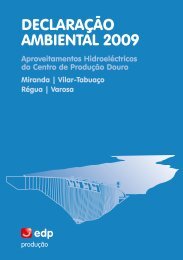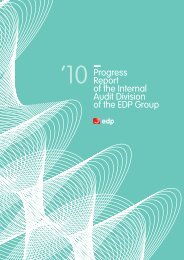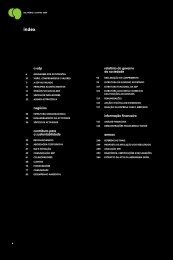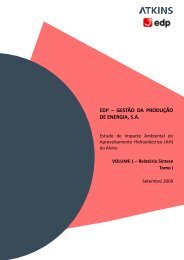notes to the consolidated and company financial statementsfor the <strong>EDP</strong> years - Energias ended Portugal, 31 december S.A. 2012 and 2011Notes to the Consolidated and Company Financial Statementsfor the years ended 31 December 2012 and 20111. ECONOMIC ACTIVITY OF <strong>EDP</strong> GROUPThe Group’s parent company, <strong>EDP</strong> – Energias de Portugal, S.A. (<strong>EDP</strong>, S.A.), was incorporated in 1976 as a result of the nationalisation and merger of the majorPortuguese companies in the electricity sector operating in mainland Portugal. <strong>EDP</strong> S.A.'s head office is located in Lisbon at Praça Marquês de Pombal, 12. During1994, as established by Decree-laws 7/91 and 131/94, the <strong>EDP</strong> Group (<strong>EDP</strong> Group or Group) was set up following the split of <strong>EDP</strong>, S.A., which led to a number of directlyor indirectly wholly owned subsidiaries of <strong>EDP</strong>, S.A.The Group’s businesses are currently focused on the generation, distribution and supply of electricity and distribution and supply of gas. Although complementary, theGroup also operates in related areas such as engineering, laboratory tests, vocational training, energy services and property management.The <strong>EDP</strong> Group operates essentially in the European (Portugal, Spain and France) and American (Brazil and the United States of America) energy sectors.Activity in the energy sector in PortugalElectricityThe National Electricity System (SEN) basis of organization and operation, as well as the general basis applicable to the production, transportation, distribution andsupply activities of electricity, and to the market organization, are established by the Decree-Law 29/2006 of 15 February, this DL was developed by the DL 172/2006 of23 August. The DL 29/2006 was updated by DL 104/2010 of 29 September, by DL 78/2011 of 20 June, by the DL 75/2012 of 26 March and by the DL 215-A/2012 andB/2012 of 8 October, incorporating essentially the principals of the European Parliament and Council’s Directive 2009/72/CE of 13 July, establishing common rules forthe electricity internal market.The National Electricity System (SEN) includes the activities of generation and supply of electricity under free competition conditions, subject to licensing, and theactivities of transmission and distribution provided through the award of public service concessions.Transmission, distribution and supply of last resort activities are subject to regulation from Entidade Reguladora dos Serviços Energéticos - ERSE (Energy SectorRegulator), which is responsible for the preparation, issuance and enforcement of regulations and for establishing the tariffs and prices related to network usage -access tariffs - and electricity supply for clients in the regulated market - electricity tariffs charged by the Supplier of Last Resort.For transmission, distribution and supply of last resort activities, the law establishes a remuneration right fixed by ERSE, under the tariff regulations, in order toeconomic and finance balance in terms of efficient management.Electricity transmission is ensured by the National Transportation Network (RNT) and is carried out under public service concessions, exclusively by REN - RedesEnergéticas Nacionais, SGPS, S.A., for a period of 50 years.GenerationThe generation of electricity covers generation under ordinary and special regimes. Under the ordinary regime, where <strong>EDP</strong> Group is represented by <strong>EDP</strong> Gestão daProdução, S.A., electricity is generated and sold under free market conditions, in organised markets or through bilateral agreements, being subject only to licensing.The special regime (PRE) allows producers to deliver electricity to the network, through bilateral agreements with the Supplier of Last Resort (CUR), being subject tospecific legislation, namely to promote the use of endogenous renewable resources, cogeneration or micro generation. The <strong>EDP</strong> Group is present in this segmentthrough its subsidiaries <strong>EDP</strong> Gestão da Produção, S.A. and <strong>EDP</strong> Renováveis Portugal, S.A., among others.Following the publication of Decree-Law 240/2004 of 27 December, which established the creation of a compensation mechanism to maintain the contractualbalance (CMEC), in January 2005 the <strong>EDP</strong> Group signed the early termination of contracts for the Power Purchase Agreements (PPAs) related to the binding electricityproduction plants of the <strong>EDP</strong> Group, effective as of 1 July 2007, date of the launch of the Iberian Electricity Market (MIBEL).On 16 February 2007 the Portuguese Government confirmed its decision to early terminate the PPAs and implement the CMEC mechanism and defined the rules tocalculate the compensations due to the power generators for such early termination, which essentially consisted in an adjustment of the reference market price ofelectricity used to calculate the CMEC initial compensation amount. On 15 June 2007, <strong>EDP</strong> and REN agreed on the early termination of the PPAs, effective as of 1 July2007. The new CMEC regulation sets the compensation due at 833,467 thousands of Euros, which in accordance with the legislation can be subject to securitisation.In June 2007, Decree-Law 226-A/2007 of 31 May, which approves the new legal regime for using hydric resources under the terms of the new Water Law (Lei daÁgua), came into force. This Decree-Law extends the period on which the companies, owning the hydroelectric plants relating to the various dams, can operate thepublic hydric resources. The extension of the operating period, and the consequent extension of the useful life of the related hydraulic fixed assets, implied a paymentby the holders of the hydroelectric plants of an amount of economic and financial compensation. On that basis, the Government (INAG), REN and <strong>EDP</strong> Gestão daProdução de Energia signed on 8 March 2008, several service concession arrangements for which <strong>EDP</strong> Gestão da Produção de Energia paid approximately 759millions of Euros for the extension of the period to operate the public hydric domain for an additional average period of 26 years.It is expected an adjustment to the interest rate applicable to the tariff repercussion of the yearly fixed amount of the costs for maintenance of the contractual balance(CMEC), for the period 2013 to 2027, by an average amount of 13 millions of Euros per year, corresponding to a present value of 120 millions of Euros. This adjustmentresults from the calculation mechanism of the CMEC fixed amount interest rate established under Decree-Law 240/2004, of 27 December.On 20 August 2012, the Law 251/2012 was published. This regulation replaces the previous mechanisms and establishes a new incentive scheme to energygenerators. Capacity payments should contribute decisively and rationally to maintain the production capacity of electricity (availability incentive) and to perform futureinvestment in new production capacity (investment incentive), and therefore, to ensure security supply levels that are not guarantee by the operation of the normalmarket mechanisms. Availability incentive is applicable to thermoelectric power plants until the end of the operating license, beginning in the calendar year followingthe date of termination of the PAF ("Programa de Apoio Financeiro"). This incentive corresponds to an annual compensation of 6,000 Euro/MW/year. Investmentincentive is applicable to new hydroelectric power plants and power enhancement projects, during the first 10 years after the formal recognition of their eligibility toreceive the incentive.<strong>EDP</strong> - <strong>Annual</strong> <strong>Report</strong> 2012171
notes to the consolidated <strong>EDP</strong> and - Energias company de Portugal, financial S.A. statementsfor the Notes years to the ended Consolidated 31 december and Company 2012 Financial and Statements 2011for the years ended 31 December 2012 and 2011DistributionElectricity distribution is carried out through the National Distribution Network (RND) and consists of a medium and high-tension network and a low-tension distributionnetwork, exclusively under public service concessions.The distribution of electricity in medium and high-tension has been licensed to <strong>EDP</strong> Distribuição by the Portuguese Government for a period of 35 years, from 25February 2009.In accordance with specific legislation (Decree-law 344-B/82), the right to distribute low-tension electricity in Portugal is attributed to the municipalities (localauthorities). However, Service Concession Arrangements were celebrated generally with a 20 year term between each of mainland Portugal municipalities and <strong>EDP</strong>Distribuição. These concessions are in return for payment of a rent to the respective municipalities, determined in accordance with Decree-Law 230/2008 of 27November.SupplyThe Electricity supply market is open to competition, subject only to a licensing regime. Suppliers have the right of access to the national transmission and distributionnetworks upon payment of the access charges set by ERSE. The activity of free supply is developed by <strong>EDP</strong> Comercial, S.A. The activity of supply of last resort (CUR),including universal public service obligations, is guaranteed by <strong>EDP</strong> Serviço Universal, S.A., a company wholly owned by <strong>EDP</strong> Distribuição S.A.Electric Energy Price RegimeIn the non-regulated market, electricity tariffs are defined by an agreement between each supplier and its customers. In the regulated market the tariffs charged bythe Supplier of Last Resort are defined by ERSE.The Decree-Law 104/2010 of 29 September, establishes the end of regulated tariffs for very high, high, medium and low-tension customers from 1 January 2011. Forthe low-voltage segment, the Decree-Law 75/2012 of 26 March, establishes the extinction of the regulated tariffs for sale to final customers from 1 July 2012 forcustomers with contracted power higher or equal to 10.35 kVA, and from 1 January 2013, for customers with contracted power less than 10.35 kVA. This law alsoestablishes a system of transitional rates set by ERSE, as well as for economically vulnerable customers the right to join the contract on the open market or choose tokeep the supply by the supplier of last resort, benefiting, in any case from discounts in the price of access provided by law.Public Domain AssetsIn Portugal some fixed assets relating to electricity generation and distribution in the regulated market are subject to the public domain regime. These assets aredirectly related with the Group's activity, which can freely manage them, but cannot dispose of them for private commercial purposes while they are related with thepublic domain regime.GasThe National Natural Gas System (SNGN) basis of organization and operation, were established by the Decree-Law 30/2006 of 15 February. This DL was developed bythe DL 140/2006 of 26 July , that established the general basis applicable to the SNGN activities. The DL 231/2012 of 26 October, proceeds to the third amendment tothe DL 140/2006, changed by the DL 65/2008 of 9 April and by the DL 66/2010 of 11 June, incorporating essentially the principles of the European Parliament andCouncil’s Directive 2009/73/CE of 13 July, establishing common rules for the natural gas internal market.In the distribution activity for natural gas, <strong>EDP</strong> Group develops its activity in Portugal through its subsidiary Portgás, S.A. <strong>EDP</strong> Group is present in the commercializationof natural gas, either in the regulated market (<strong>EDP</strong> Gás Serviço Universal) or the free market (<strong>EDP</strong> Gás.com and <strong>EDP</strong> Comercial). <strong>EDP</strong> Gás.com and <strong>EDP</strong> Comercial, witha trading license in the free market since 2008 and 2010, respectively, have operated in the market since the start of 2009. Additionally, the Group develops the supplybusiness of propane gas, through <strong>EDP</strong> Gás GPL,S.A.On 15 June 2012, the tariffs set by ERSE were published for the years 2012-2013. The income allowed for Portgás S.A. include the initial revaluation of its assets (withreference to 31 December 2007), approved by the Finance Ministry.Activity in the energy sector in SpainElectricityIn Spain, Hidroeléctrica del Cantábrico (HC Energia) is the parent company of an industrial group that operates in the electricity and gas sectors. In the electricity sector,HC Energia generates, distributes and supplies electricity. Production is based essentially on traditional coal thermal power plants and, on a smaller scale, onhydroelectric and nuclear power plants.Electric Sector RegulationOn 27 November 1997 the Electric Sector's Law 54/1997 was approved, which (i) implements the principles included in the Protocol signed on 11 December 1996between the Ministry of Industry and Energy and the major electric power companies regarding greater liberalization and competition in the electricity sector and (ii)incorporates into Spanish law the provisions contained in Directive 96/92/EC on common rules for the internal electricity market. Additionally, on 6 July 2007 the Law17/2007 of 4 July came into force, amending the Law 54/1997, to adapt it to the Directive 2003/54/EC of the European Council and Parliament of 26 June 2003 oncommon rules for the internal market of electricity. Law 54/1997 was updated by the Royal Decree 13/2012 of 30 March, incorporating the principals of the EuropeanParliament and Council’s Directive 2009/72/CE of 13 July which came to repeal the Directive 2003/54/CE.172A World Full Of Energy
- Page 1:
Impresso em papel elaborado com cel
- Page 6 and 7:
: edp :index6 edp6 message to share
- Page 8 and 9:
: edp :EDP - Annual Report 20127
- Page 10 and 11:
Portugalrenewablesgás7,194 Employe
- Page 12 and 13:
: edp :1.1.3. CORPORATEBODIESboard
- Page 14 and 15:
: edp :1.1.5. principles ofsustaina
- Page 16 and 17:
: edp :BRAzILEDP Brasil distinguish
- Page 18 and 19:
: edp :1.3.2. Operating HighlightsU
- Page 20:
: edp :1.3.5. ENVIRONMENT INDICATOR
- Page 24 and 25:
: edp :strategicframeworkxxxxxxxxxx
- Page 26 and 27:
: strategic framework :Reconversion
- Page 28 and 29:
: strategic framework :EVOLUTION OF
- Page 30 and 31:
: strategic framework :million at D
- Page 32 and 33:
: strategic framework :Since 2005,
- Page 34:
: strategic framework :EDP - Annual
- Page 38 and 39:
: a edp :performance38 business40 I
- Page 40 and 41:
: performance :EDP - Annual Report
- Page 42 and 43:
: performance :By the end of the ye
- Page 44 and 45:
: performance :electricity generati
- Page 46 and 47:
: performance :EDP Distribuição h
- Page 48 and 49:
: performance :electricity AND GAS
- Page 50 and 51:
: performance :Despite the increase
- Page 52 and 53:
: performance :electricity supply i
- Page 54 and 55:
: performance :In 2012, EDPR increa
- Page 56 and 57:
: performance :3.1.3. EDP BRAsILEDP
- Page 58 and 59:
: performance :EDP brasilGENERATION
- Page 60 and 61:
: performance :Distribution of comp
- Page 62 and 63:
: performance :testing the adherenc
- Page 64 and 65:
: performance :3.4.1. managementsys
- Page 66 and 67:
: performance :In Brazil, EDP has n
- Page 68 and 69:
: performance :that 117 m 3 of oil
- Page 70 and 71:
: performance :EDP has undertaken t
- Page 72 and 73:
: performance :encourages professio
- Page 74 and 75:
: performance :The set of indicator
- Page 76 and 77:
: performance :Voice of the custome
- Page 78 and 79:
: performance :(ACAPO), are also av
- Page 80 and 81:
: performance :3.7. suppliersThe pe
- Page 82 and 83:
: performance :Transparency; Leader
- Page 84 and 85:
: performance :The following table
- Page 86:
: performance :between the local au
- Page 90 and 91:
: a edp :Corporate governance89 sta
- Page 92 and 93:
: corporate governance :STATEMENT O
- Page 94 and 95:
: corporate governance :STATEMENT O
- Page 96 and 97:
: corporate governance :I. GENERALM
- Page 98 and 99:
: corporate governance :In all othe
- Page 100 and 101:
: corporate governance :II.1.1. Cor
- Page 102 and 103:
: corporate governance :The company
- Page 104 and 105:
: corporate governance :Strategy Co
- Page 106 and 107:
: corporate governance :Companies C
- Page 108 and 109:
: corporate governance :From 22 Feb
- Page 110 and 111:
: corporate governance :The Institu
- Page 112 and 113:
: corporate governance :Careers, Mo
- Page 114 and 115:
: corporate governance :Commercial
- Page 116 and 117:
: corporate governance :Corporate S
- Page 118 and 119:
: corporate governance :new matters
- Page 120 and 121:
: corporate governance :with the Eu
- Page 122 and 123: : corporate governance :unavailabil
- Page 124 and 125: : corporate governance :in share ca
- Page 126 and 127: : corporate governance :II.19. Posi
- Page 128 and 129: : corporate governance :II.26. Rule
- Page 130 and 131: : corporate governance :II.28. Posi
- Page 132 and 133: : corporate governance :Executive B
- Page 134 and 135: : corporate governance :EDP has no
- Page 136 and 137: : corporate governance :CHAPTER III
- Page 138 and 139: : corporate governance :III.3. Hold
- Page 140 and 141: : corporate governance :Share price
- Page 142 and 143: : corporate governance :Capital Mar
- Page 144 and 145: : corporate governance :III.13. Int
- Page 146 and 147: : corporate governance :In 2012, th
- Page 151 and 152: EDP Renováveis opensfirst wind far
- Page 153 and 154: : financial report :5.1. edp group
- Page 155 and 156: : financial report :these impacts,
- Page 157 and 158: : financial report :local currency,
- Page 159 and 160: : financial report :amount of EUR 1
- Page 161 and 162: : financial report :EDP - Energias
- Page 163 and 164: : financial report :EDP - Energias
- Page 165 and 166: : financial report :EDP - Energias
- Page 167 and 168: : financial report :EDP - Energias
- Page 169 and 170: : financial report :EDP - Energias
- Page 171: 12.pdf 1 02/04/13 14:50notes to the
- Page 175 and 176: notes to the consolidated EDP and -
- Page 177 and 178: notes to the consolidated and compa
- Page 179 and 180: notes to the consolidated EDP and -
- Page 181 and 182: notes to the consolidated EDP and -
- Page 183 and 184: notes to the consolidated EDP and -
- Page 185 and 186: notes to the consolidated EDP and -
- Page 187 and 188: notes to the consolidated EDP and -
- Page 189 and 190: notes to the consolidated EDP and -
- Page 191 and 192: notes to the consolidated EDP and -
- Page 193 and 194: notes to the consolidated EDP - and
- Page 195 and 196: notes to the consolidated EDP and -
- Page 197 and 198: notes to the consolidated EDP - and
- Page 199 and 200: notes to the consolidated EDP - and
- Page 201 and 202: notes to the consolidated EDP - and
- Page 203 and 204: notes to the consolidated EDP and -
- Page 205 and 206: notes to the consolidated EDP - and
- Page 207 and 208: notes to the consolidated EDP - and
- Page 209 and 210: notes to the consolidated and compa
- Page 211 and 212: notes to the consolidated EDP - and
- Page 213 and 214: notes to the consolidated EDP - and
- Page 215 and 216: notes to the consolidated EDP - and
- Page 217 and 218: notes to the consolidated EDP - and
- Page 219 and 220: notes to the consolidated EDP and -
- Page 221 and 222: notes to the consolidated EDP and -
- Page 223 and 224:
notes to the consolidated EDP - and
- Page 225 and 226:
notes to the consolidated EDP - and
- Page 227 and 228:
notes to the consolidated EDP - and
- Page 229 and 230:
notes to the consolidated EDP - and
- Page 231 and 232:
notes to the consolidated EDP and -
- Page 233 and 234:
notes to the consolidated EDP - and
- Page 235 and 236:
notes to the consolidated EDP and -
- Page 237 and 238:
notes to the consolidated EDP - and
- Page 239 and 240:
notes to the consolidated EDP - and
- Page 241 and 242:
notes to the consolidated EDP - and
- Page 243 and 244:
notes to the consolidated EDP - and
- Page 245 and 246:
EDP - Energias de Portugal, S.A.Not
- Page 247 and 248:
notes to the consolidated EDP - and
- Page 249 and 250:
notes to the consolidated EDP and -
- Page 251 and 252:
notes to the consolidatedEDPand- En
- Page 253 and 254:
notes to the consolidated EDP - and
- Page 255 and 256:
notes to the consolidated EDP and -
- Page 257 and 258:
notes to the consolidated and compa
- Page 259 and 260:
notes to the consolidated and compa
- Page 261 and 262:
notes to the consolidated and compa
- Page 263 and 264:
notes to the consolidated and compa
- Page 265 and 266:
notes to the consolidated and compa
- Page 269 and 270:
Hydroelectric powerplant of Bempost
- Page 271 and 272:
: annexes :annexesannex Ifinal refe
- Page 273 and 274:
: annexes :by Instituto Superior de
- Page 275 and 276:
: annexes :Chairman of Euronext Lis
- Page 277 and 278:
: annexes :basis. He was designated
- Page 279 and 280:
: annexes :annex IIItransactions pe
- Page 281 and 282:
: annexes :EDP’s material issues
- Page 283 and 284:
: annexes :Simultaneously, the foll
- Page 285 and 286:
: annexes :GRI complianceThis repor
- Page 287 and 288:
: annexes :286A World Full Of Energ
- Page 289 and 290:
: annexes :288A World Full Of Energ
- Page 291 and 292:
: annexes :290A World Full Of Energ
- Page 293 and 294:
: annexes :292A World Full Of Energ
- Page 295 and 296:
: annexes :294A World Full Of Energ
- Page 297 and 298:
: annexes :296A World Full Of Energ
- Page 299 and 300:
: annexes :298A World Full Of Energ
- Page 301 and 302:
: annexes :300A World Full Of Energ
- Page 303 and 304:
: annexes :302A World Full Of Energ
- Page 305 and 306:
: annexes :304A World Full Of Energ
















